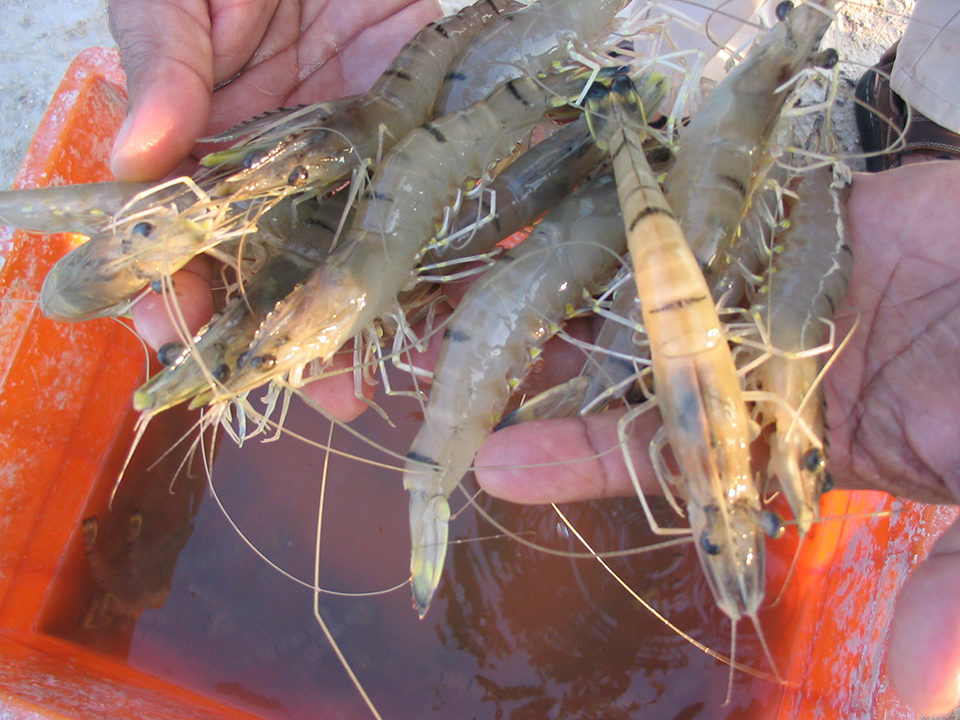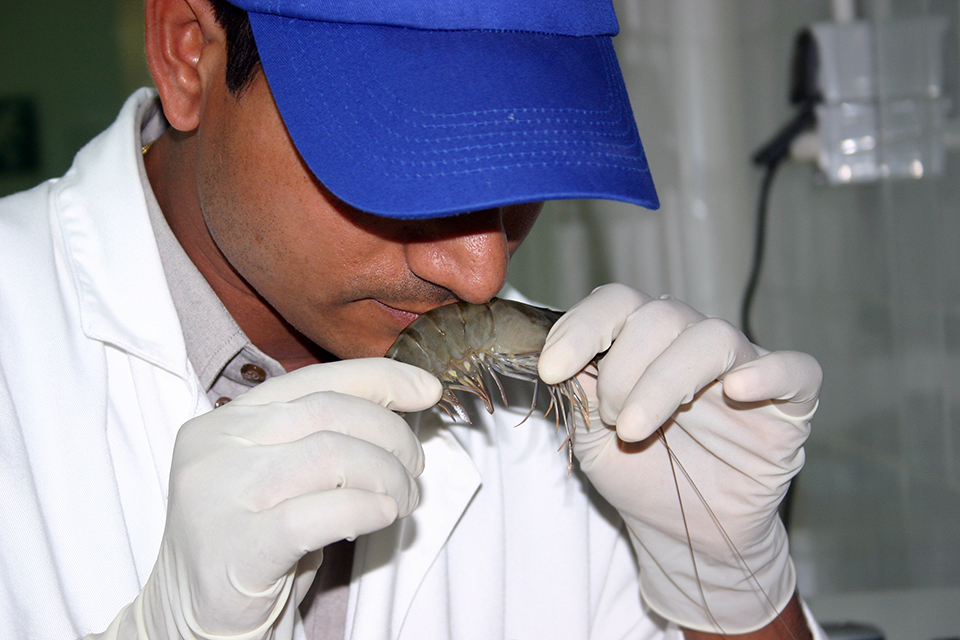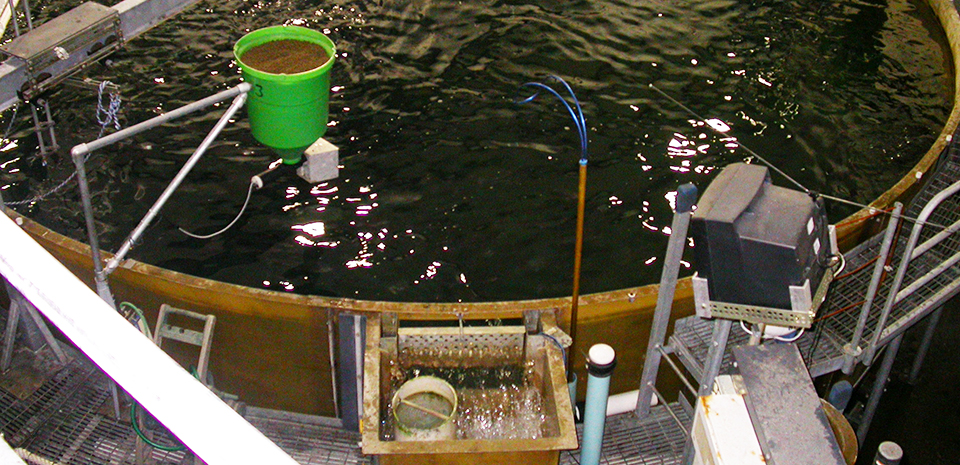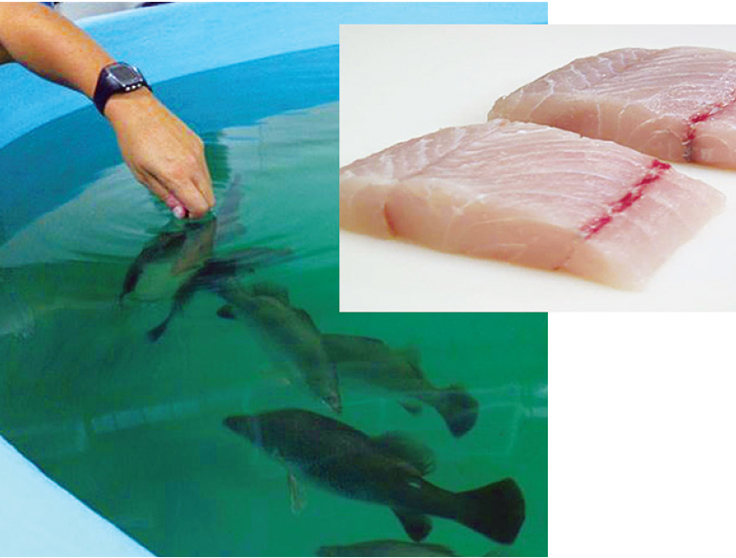Environmental, endogenous factors

Water used in aquaculture production can acquire flavors from industrial installations upstream. Due to the lack of available information verifying the seafood-tainting capabilities of industrial compounds, there is little clear information that precisely relates a source of contamination to unacceptable flavors in fish and shellfish produced downstream. Even the placement of caged fish near effluent sources has not always resulted in a clear identification of a polluting source.
Despite the difficulty in establishing clear links between industrial effluents and off-flavors, some compounds have been identified. In one river, industrial compounds responsible for flavor tainting included alkylphenols (2-isopropyl-, 3-isopropyl, 4-isopropyl-, 2,4-diisopropyl-, 2,5-diisopropyl-, 2,6-diisopropyl-, 3,5-diisopropyl-, 5-methyl-2-isopropyl- and 2-methyl-5-isopropyl-) and thiophenol.
Chlorination of wastewater from municipal or industrial sources has resulted in the formation of 2,4,6-trichloroanisole and other chlorinated anisoles, which have been related to off-flavors in fish. Ozonation is known to produce a variety of off-flavors as well, but its contribution to unacceptable flavor or odor in aquaculture has not been studied.
Off-flavor from enzymes
Fish lipids are very susceptible to oxidation because of a high degree of acyl unsaturation. Lipoxygenase present in fish tissues can initiate the oxidation of polyunsaturated fatty acids to produce acyl hydroperoxides. Thus, oxidative off-flavored short-chain carbonyl compounds such as 4-heptanal, 2,4-heptadienal, 2-pentenal, 3-hexenal and 2,4-decadienal increase during cold storage of some aquacultured fish species.
The effects of lipoxygenase on lipid oxidation and off-odor formation has been studied in silver carp, Hypophthalmichthys molitrix, where it was associated with a strong fishy odor. It is likely that 2,4-heptadienal contributes to fishy odors, while hexanal and nonanal are responsible for oxidized oil odors.
Off-flavor from microorganisms
Algae have been responsible for the production of compounds that result in objectionable tastes and odors. Some algae produce isopropyl di- and trisulfide, isopropyl mercaptan, methyl isothiocyanate, isopropyl methyl sulfide and isopropyl methyl sulfide. Dimethyl sulfide, which is also produced, has an odor threshold concentration of just 0.33 ng/g in water but has been found in canned fish at concentrations of 8.4 µg/g (8,400 ng/g).
The contribution of bacteria to flavor-tainted seafoods is well known and documented. Microorganisms in soil produce several volatile compounds, such as 2-isopropyl-3-methoxy pyrazine. However, the off-odors and off-flavors produced by bacteria living on aerobically stored fish are also dependent upon the fish species and its origin.
The spoilage of temperate-climate marine fish species is characterized by the development of ammoniacal, fishy, rotten and hydrogen sulfide odors and flavors. In tropical and freshwater fish, such spoilage is characterized by the presence of fruity and sulfhydryl odors and flavors.
A four-phase pattern of change in the flavor quality of fish occurs post-harvest. These changes are tied to initial contamination of the fish by microorganisms, the growth of anaerobic bacteria, development of surface slime and the subsequent growth of anaerobic bacteria.
Off-odors
Usually, the first sign of off-odor is the ammoniacal odor of trimethylamine, which comes from the degradation of trimethylamine oxide. The next stage is the development of sulfurous and putrid odors caused by compounds primarily formed by the microbial decomposition of amino acids. Most bacteria are capable of producing one or more sulfides (hydrogen sulfide, methanethiol, dimethyl sulfide, dimethyl disulfide) from either cysteine or methionine.
Chilled fish can develop a fruity odor during the early stages of spoilage. The compounds responsible for this are the ethyl esters of acetic, butanoic and hexanoic acids. These compounds are thought to be formed from mono-amine, monocarboxylic acids.
Crustacean off-flavors
The microbiological origins of off-flavors in crustaceans have received little attention compared to those of fresh- and saltwater fish. The majority of the literature has focused on the Australian deep-sea prawn, Hymenopenaeus sibogae, which can develop a distinctive garlic-type flavor that on occasion renders the product unacceptable to consumers. A similar off-flavor has also been reported in sand lobsters.
The prawns are not microbiologically spoiled, and the off-flavor is exclusively concentrated in the animals’ gut. The responsible compound has been identified as bis-(methylthio)-methane. The organism or organisms causing the off-flavor has not been identified.
Dimethyl trisulfide was identified as the cause of an unpleasant cooked onion odor in rejected catches of deep-sea prawns. Indole was also identified in the prawns. The flesh of the prawns was discolored and slimy to the touch. The prawns contained a high microbiological population, but the cause of the off-flavor could not be attributed to any of the microorganisms.
Garlic off-flavors have been shown to be due to the presence of trimethylarsine in both deep-sea and shallow water prawns. Again, the prawns were not microbiologically spoiled, and the compound was concentrated in the gut.
Environmental arsenic is readily transformed into alkylarsines by many bacteria under reducing conditions. Mold and yeast both produce trimethylarsine, while bacteria produce dimethylarsine. Algae are capable of converting arsenite to trimethylarsine oxide. It should be noted that prawns are known to accumulate inorganic arsenic, and the presence of some bacteria could convert the compound to trimethylarsine.
Editor’s Note: Part I of this series discussed the effects on aquacultured products of off-flavors caused through the biological production of geosmin and 2-methylisoborneol. Part III will cover the flavor effects of aquaculture feeds, processing and storage conditions.
(Editor’s Note: This article was originally published in the July/August 2011 print edition of the Global Aquaculture Advocate.)
Author
-

George J. Flick, Jr., Ph.D.
Food Science and Technology Department
Virginia Tech/Virginia Sea Grant (0418)
Blacksburg, Virginia 24061 USA[117,100,101,46,116,118,64,103,107,99,105,108,102]
Tagged With
Related Posts

Intelligence
Off-flavors in aquaculture products, part 1
Off-flavors in pond and recirculating aquaculture systems have occurred through the biological production of geosmin and 2-methylisoborneol. The compounds are rapidly absorbed through the gills of fish, but depuration can require days or weeks.

Health & Welfare
Off-flavors in salmonids raised in RAS
The presence of compounds such as geosmin and 2-methylisoborneol (MIB) in recirculating aquaculture systems (RAS) can result in earthy or musty off-flavors in salmonids raised in the systems.

Health & Welfare
Biofloc technology reduces common off-flavors in channel catfish
In studies that used biofloc systems to culture channel catfish, culture tanks were susceptible to episodes of geosmin and 2-methylisoborneol and subsequent bioaccumulation of off-flavors in catfish flesh.

Intelligence
Adding flavor complexity to farmed barramundi
Organoleptic attributes such as flavor and aroma are among the most important factors that influence consumer acceptability and demand for fish products. Consumers have identified farmed fish as less complex and lacking “sealike” or “sea-fresh” flavors and aromas.

